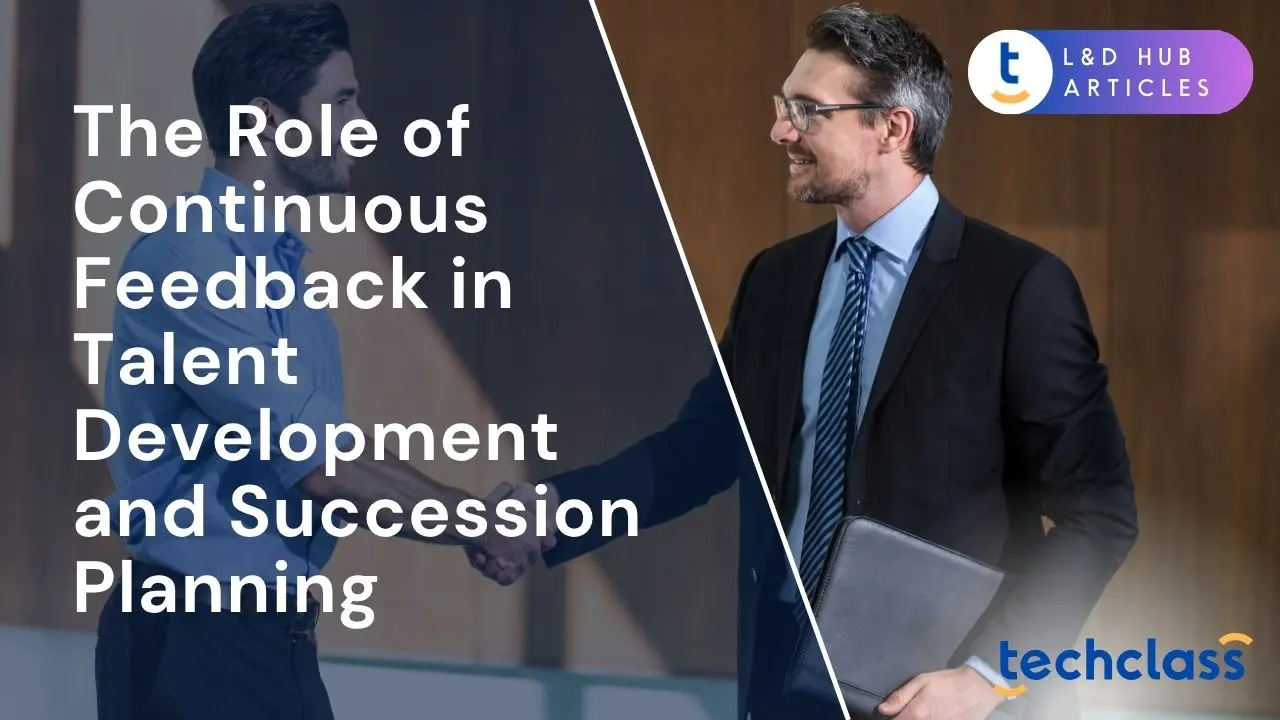
In today’s fast-paced business environment, companies can no longer rely on once-a-year performance appraisals to develop their people. The next generation of leaders is being shaped now, and they need guidance and coaching on an ongoing basis. Continuous feedback, regular, real-time input on performance, has emerged as a crucial strategy for nurturing employee growth and building a strong leadership pipeline. By moving beyond infrequent annual reviews to a culture of continual coaching, organizations create an environment where talent can flourish in real time. This proactive approach not only helps employees build skills and stay engaged, but it also ensures that high-potential individuals are being prepared to step into key roles when the business needs them. In short, continuous feedback ties everyday employee development to long-term succession success, turning daily interactions into opportunities to groom tomorrow’s leaders.
Effective talent management has two critical goals: developing employees’ capabilities in their current roles and preparing them for future roles. Talent development focuses on helping employees grow their skills, knowledge, and experience through training, coaching, and new challenges. Succession planning, on the other hand, is the process of identifying future leadership needs and cultivating internal candidates to fill those key positions. These two efforts are deeply connected. In fact, the talent development piece is an integral part of succession planning, you can’t have a robust succession plan without actively developing your people. Organizations need to anticipate the skills and leadership competencies they will require in the coming years and ensure that employees are continuously learning and improving in those areas. By linking talent development programs with succession objectives, companies create a steady pipeline of “ready-now” candidates who can step up when a manager retires, a director moves on, or a new leadership role emerges. This alignment means that every development activity (from workshops to stretch assignments and mentorship) is also a succession activity. As leadership expert Marshall Goldsmith famously noted, plans alone do not develop anyone, only development experiences develop people. In practice, this means that beyond having names on an org chart as potential successors, organizations must give those future leaders meaningful growth experiences. Continuous feedback is a key mechanism to drive those experiences, guiding employees along their development paths and ensuring the organization’s long-range leadership needs will be met.
Traditional annual performance reviews often provide too little, too late. Employees receive feedback only once a year, which can make the guidance stale and the course-corrections delayed. In contrast, continuous feedback involves frequent, timely conversations, weekly one-on-ones, monthly check-ins, project post-mortems, and real-time coaching, that keep employees on track throughout the year. Research supports this shift: the vast majority of employees prefer real-time feedback over infrequent formal reviews, and organizations that have adopted continuous feedback report significantly lower turnover rates and more proactive employees. The reasons are clear. Regular feedback helps employees adjust their efforts quickly, improving performance in the moment rather than months after mistakes have happened. It also reinforces positive behaviors immediately, which boosts morale and motivation. For example, one tech company implemented brief weekly check-in meetings between team leaders and their members; within six months, they observed a 15% boost in productivity, as employees felt more supported and were able to address challenges promptly. By replacing annual evaluations with ongoing dialogue, companies can create a more agile and responsive workforce. Moreover, frequent feedback reduces the anxiety and “surprise factor” that often accompany yearly reviews. Instead of dreading a once-yearly critique, employees come to see feedback as a normal, helpful part of work life, a tool for growth rather than a judgment. This change in mindset builds trust between staff and management. It also aligns with the expectations of today’s workforce: younger professionals, in particular, have grown to expect continuous coaching and opportunities to learn. Ultimately, shifting to continuous feedback is about creating a culture where improvement is constant and employees are actively engaged in their development throughout the year.
A strong feedback culture directly fuels talent development. When managers and peers are giving constructive input on a regular basis, employees gain clarity on what they are doing well and where they can improve, in real time. This accelerates learning. Instead of waiting months to discover a performance gap or a skill deficiency, continuous feedback allows for immediate identification of development needs. For instance, a healthcare organization introduced real-time performance dashboards and regular feedback sessions for its staff. By correlating feedback data with patient satisfaction metrics, they quickly spotted specific training gaps among the nursing team. Addressing those needs promptly through coaching and workshops led to a 20% improvement in patient care ratings. This example shows how ongoing feedback doesn’t just point out problems, it leads directly to targeted development actions that yield measurable results.
Continuous feedback also fosters a growth mindset across the organization. Employees come to view each piece of feedback as a chance to learn something new or sharpen their skills, rather than as criticism. Over time, this creates a culture of continuous learning where individuals actively seek feedback to grow. Companies like Adobe provide a well-known case study: Adobe replaced its traditional annual review system with a continuous feedback program called “Check-in.” Managers and employees now have frequent, informal discussions about goals and performance. As a result, Adobe reported higher employee satisfaction and faster resolution of performance issues, because people receive guidance when it matters most. Equally important, continuous feedback keeps employees aligned with organizational goals. In frequent conversations, managers can tie an individual’s tasks and progress to the bigger picture, reminding them how their development contributes to the company’s mission. This alignment increases engagement, as people see clear linkages between improving their own skills and advancing the organization’s objectives. It also helps in recognizing achievements more regularly. A culture of continuous feedback naturally means celebrating small wins and improvements along the way, which boosts morale and confidence. All of these factors, timely skill development, a learning-oriented mindset, goal alignment, and recognition, contribute to more robust talent development. Employees feel invested in and valued, and they are more likely to stay and grow with the company. In turn, the organization benefits from a more capable, adaptable workforce. Every day becomes an opportunity for employees to develop, guided by the steady compass of ongoing feedback from their leaders and peers
Continuous feedback isn’t just about improving day-to-day performance, it’s also a strategic tool for succession planning. One of the biggest challenges in succession planning is accurately identifying and preparing the right people for future leadership roles. Relying on static, infrequent evaluations or subjective judgments can lead to the wrong candidates being chosen or promising talent being overlooked. Ongoing feedback helps solve this by providing a richer, real-time picture of each employee’s performance, potential, and progress. When managers meet regularly with employees and provide coaching, they gain deeper insight into who consistently steps up, who learns quickly from feedback, and who demonstrates leadership qualities over time. These insights are invaluable for spotting high-potential talent early and nurturing them deliberately.
For example, a financial services firm leveraged continuous performance tracking and feedback data to guide its promotions and succession decisions. Managers could see performance trends and growth trajectories for employees, rather than just a snapshot from an annual review. This data-driven approach ensured that the right talent was placed in leadership roles, those who had demonstrated improvement, initiative, and readiness through continuous feedback cycles were the ones moving up. It also allowed the company to detect underperformance or skill gaps early and provide support long before an employee would be considered for a bigger role. In practice, continuous feedback means that potential successors are never left to develop in a vacuum. They receive regular mentorship, course corrections, and encouragement tailored to prepare them for greater responsibilities. A structured succession plan might identify “Employee A” as a possible future manager, but it’s the ongoing feedback and development plan, monthly coaching sessions, stretch assignments with feedback afterward, leadership training with follow-up notes on progress, that will actually equip that employee to succeed. This continuous development loop is what turns succession planning from a static list into a living, breathing process.
Another benefit is the transparency and engagement it brings to succession efforts. In organizations where continuous feedback is the norm, employees understand that improvement is expected and supported at all levels. High-potential individuals are more likely to be engaged and stick around when they see a path for advancement that comes with guidance. They get frequent input on what they need to work on to reach the next level, which demystifies the journey to leadership. This can help prevent the scenario where an identified successor leaves the company due to feeling stagnant or unrecognized. Additionally, regular feedback can help remove bias from succession decisions. Traditional succession tools (like the nine-box grid of performance vs. potential) often rely on infrequent assessments that might be influenced by recency or subjective bias. In contrast, a history of continuous feedback provides a more objective record of an employee’s development over time and the opportunities they’ve seized to grow. Leadership teams can review this rich feedback history when considering promotions, making succession discussions more evidence-based.
In essence, ongoing feedback turns succession planning into a continuous learning process rather than a one-time event. It aligns with the idea that preparing a successor is not achieved by a nomination or a yearly review, but through sustained development experiences. Companies that integrate continuous feedback into succession planning are far better positioned to avoid leadership gaps. They won’t be caught off guard by a sudden departure, because they have been steadily grooming multiple team members who are ready (or nearly ready) to step up. Over the long run, this approach builds a resilient leadership pipeline. Future leaders are not just chosen, they are made, through the cumulative effect of years of coaching, advice, and adjustments that continuous feedback provides.
Creating a culture of continuous feedback requires deliberate effort and changes in mindset. Here are some best practices and strategies HR leaders and business owners can implement to make ongoing feedback a natural part of their organization’s DNA:
Implementing these practices helps overcome common challenges, such as initial resistance to giving or receiving feedback. It’s normal that some employees might feel uncomfortable with more frequent feedback at first, especially if they’ve only experienced feedback as a negative or punitive event in the past. That’s why focusing on constructive, future-oriented feedback (sometimes called “feed-forward”) and ensuring managers also highlight positives is so important. Over time, as the benefits become evident, better team performance, quicker problem-solving, and employees taking more initiative, even skeptics will see the value. Leadership commitment is key here: when top leaders consistently model continuous feedback and allocate time for development, it sends a clear message that this is not just an HR fad, but a core part of how the organization operates.
Continuous feedback is more than a performance management technique, it’s a philosophy of continuous improvement that transforms how an organization develops its people. By fostering a workplace where feedback is regular, constructive, and tied to development, companies set the stage for both immediate performance gains and sustainable long-term success. Employees become more engaged in their work because they know where they stand and how they can grow; managers become better talent coaches; and future leaders are systematically cultivated rather than chosen in a rush during a crisis. In the big picture, a culture of continuous feedback leads to a more agile and resilient organization. It encourages innovation (people are more willing to take smart risks when they know they’ll get supportive guidance) and builds trust through transparency and open communication.
For HR professionals and business leaders, the takeaway is clear. If you want to future-proof your workforce and fill your leadership bench with strong internal talent, invest in continuous feedback practices today. The companies that thrive through change and competitive challenges are those that continuously develop their employees and adapt quickly. By giving people the ongoing feedback and support they need, you’re not just managing performance, you’re actively shaping the next generation of talent and leaders within your organization. In doing so, talent development and succession planning stop being periodic HR exercises and become a natural, ingrained part of daily work life. Over time, the payoff is substantial: higher productivity, better retention of top performers, a more innovative culture, and a deep pipeline of prepared leaders ready to take the helm. In a world where change is constant, organizations that embrace continuous feedback will be best equipped to grow, endure, and succeed for years to come.
Continuous feedback provides real-time insights, helps employees grow skills proactively, and ensures a steady pipeline of future leaders.
It offers more timely guidance, boosts engagement, reduces turnover, and creates an agile, responsive workforce.
Training managers as coaches, establishing regular check-ins, encouraging peer feedback, leveraging technology, and integrating feedback into development plans.
It offers clear, ongoing performance insights, helps identify high-potential employees early, and prepares them through tailored development experiences.


